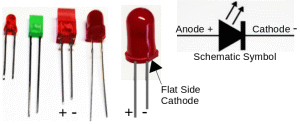Glossary L
Latching
Latching can apply to both mechanical devices and electronic circuits.
An example of mechanical latching would be a push on / push off switch, see here. See also description of a latching relay. (e.g. relay)
An example of an electronic latch would be a flip-flop or bistable circuit.
A standard relay may be made self latching by supplying a current path for the coil through one of its normally open contact sets.
LCB
Layout Control Bus
The old way of connecting up a model railway layout was for every point and signal to have a set of wires back to the control box where switches were located for the operator to use. The idea of a layout control bus is to have a small number of wires (the bus) carry the instructions around the layout. Several different ways of doing this have been devised and some of them are described on the Knowledgebase. Using modern technology the switches can be implemented in a lot of different ways or even be replaced by automation.
LCC
 Layout Command Control (LCC) is a system for controlling all the functions on your layout that don’t have to do with how fast the locomotive is moving – things like signals, or sounds, or passenger car lighting. LCC is NMRANet, just under a different name. LCC is designed as a separate, generic control bus which is positioned to take the load off your throttle bus. It is a bi-directional data bus that can send and receive data. Since it is an NMRA Standard, you are not confined to one manufacturer's products. Any manufacturer can make LCC-compatible devices.
Layout Command Control (LCC) is a system for controlling all the functions on your layout that don’t have to do with how fast the locomotive is moving – things like signals, or sounds, or passenger car lighting. LCC is NMRANet, just under a different name. LCC is designed as a separate, generic control bus which is positioned to take the load off your throttle bus. It is a bi-directional data bus that can send and receive data. Since it is an NMRA Standard, you are not confined to one manufacturer's products. Any manufacturer can make LCC-compatible devices.
Lead free
This is a change in the content of solder. Lead free solder is generally recommended due to Health and Safety considerations, but 60:40 tin:lead is preferred for electronic kits and is still available from suppliers such as Rapid Electronics. It is important to note that lead and lead free solders require different soldering iron temperatures.
LED
A Light Emitting Diode (LED) is a type of diode that emits light when an electric current is passed through it. LEDs can be manufactured to cover the visible spectrum as well as the IR and UV spectrums. LEDs come in many colors, sizes and styles, and some include multiple diodes internally allowing more than one color to be produced. LEDs are low voltage devices that usually require a resistor to limit the current through the device. Different LEDs will need different resistor values, even if they look similar.
Most LEDs, when manufactured, provide a way to tell the polarity. The longer leg is the anode or positive end. The shorter leg is usually the cathode or negative end (same as the banded end of a regular diode). Many larger LEDs may also have a flat part molded into the round base to indicate the cathode lead. If you cannot tell which leg is the positive you may try using a 680 ohm current limiting resistor (or 1000 ohm with 12V) in series with the LED and a 5V power source to see which way lights the LED.
https://www.merg.org.uk/merg_resources/led.php
http://electronicsclub.info/leds.htm
Lenz
A German DCC system and decoder manufacturer. Lenz invented the DCC technologies which became standardised by the NMRA
LiFo
Last in First out, data buffer where the most recent entry is the first to be retrieved. Commonly referred to in programming as a 'Stack' it is used to save the return address (Program Counter) and other data that must be restored when a Sub Routine terminates.
Lighting decoder
A DCC decoder made especially for lights for a loco or carriages.
Logic
In a model railway it is a way to do step by step sequence to make the train do what you require. From an electronic component perspective, logic generally refers to IC logic gates that perform logical functions, such as AND, OR or Invert, to binary signals. A logic device may perform one function like ANDing two signals, or may be very complicated like a frequency divider IC.
